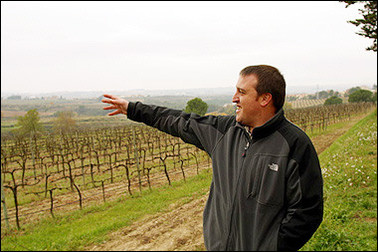Catalonia’s Cava bubbly chasing champagne’s tail in exports
December 27, 2005 - Agence France Presse

“When I wake up in the morning, I work out between six and seven, and then I have breakfast with tomato bread and a glass of Cava,” says Jaume Gramona, referring to Spain’s favorite sparkling wine.
Gramona is himself a Cava producer in Catalonia in northeast Spain, where 95 percent of the Spanish equivalent—and, in some foreign markets, competitor—to French champagne is made, so one might be tempted to chalk up his early morning regimen to professional zeal.
But his Catalan breakfast of champions is hardly exceptional.
“Most people who go food shopping at the market start their day with a glass,” he says.
Indeed, an early-riser visit to Barcelona’s Boqueria market bears Gramona out. At kioscos, the traditional bars that cook up the market’s freshest food, visitors grab a hearty breakfast and wash it down with a glass or two of Cava before heading off to do their shopping.
Clever wives leave their husbands at the bar so they can shop in peace.
“It used to be considered more hip to get champagne when you took a girl out,” says Gramona. “That’s not true any more.”
Certainly not in Catalonia, where Cava has a near-religious following. Its biggest success is its ability to bridge the gap between celebration and affordability. It has managed to bottle champagne’s excitement—keeping that special occasion festivity to it—without the special occasion prices.
Boosters will argue that the biggest difference between the two sparkling wines produced using the same techniques—is price. A bottle of Cava endorsed by wine critic Robert Parker can be had for about 15 dollars. Try getting a decent bottle of champagne for that price, and one sees why the Spanish, and especially Catalans, don’t even consider it a choice.
Truth be told, the Cava that can hold its own against a decent champagne is the exception rather than the rule. But Cava partisans insist that their team is catching up fast.
“If this line is champagne quality, and this one is Cava quality,” says Quim Sanchez, owner of possibly the hottest tapas bar in Barcelona, stabbing the table with two index fingers, “this is what’s happening”: the Cava finger comes up to meet the champagne finger, which doesn’t move.
Both sparkling wine regions produce and export roughly in equal measure. In 2004 221 million bottles of Cava were produced, 121 million of them exported. The Champagne region sold 123 million bottles abroad in the same year.
Outside Spain, however, top quality Cava has an image problem. “Most people think of it as ‘the cheap champagne that comes from Spain’,” says Josep Jove, export manager at organic wine and Cava producer Albet i Noya.
That reputation was built in large part by Cava heavyweights Freixenet and Codorniu, by far the biggest and best-known exporters. Though each house produces excellent boutique wines that rival most champagnes, the vast majority of their business—especially in the United States, Cava’s main foreign market—has been has been built over the last 25 years at the bottom of the bubbly market.
Smaller, artisanal producers such as Albet i Noya and Gramona have had to live with the consequences.
At Gramona in Sant Sadurni d’Anoia, marketing director Montserrat Alonso insists that quality is the key to cracking the US market, where she spent several months on reconnaissance before selling a single bottle.
She returned to Spain with a strategy for piercing that market she feared might make the management balk: avoid what one well-known sommelier refers to as the “Coca-Cola approach,” and instead offer only their best bubbly in the United States, even though they could easily sell it—and make more money doing so—in Spain.
“The population was waiting for something good,” she says, “not something cheap.”
Her bet paid off. Gramona is now available throughout the United States and already makes up half of the winemaker’s export sales.
“When people know about wine, they are willing to spend a lot of money on it,” Alonso says with a grin.
Jaume Gramona agrees that selling on value, not volume, is his company’s best bet. “Price for price, the scale is much more pitched toward Cava.”
This article also ran with: The Jamaica Observer